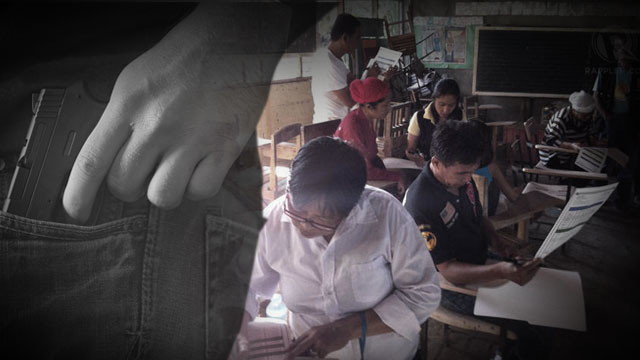SUMMARY
This is AI generated summarization, which may have errors. For context, always refer to the full article.

MANILA, Philippines – Neither poverty nor elections could be linked directly to, or cause an increase in, reported crimes. Official statistics show that crime thrives in areas where income inequality is high.
These were stressed by Jose Ramon Albert, director general of the National Statistics Coordination Board (NSCB), in a report posted on the agency’s website on February 22.
He cited the Autonomous Region of Muslim Mindanao (ARMM), which has the lowest income inequality of 0.2948 in 2009 and the lowest crime rate of 54 per 100,000 people.
In contrast, Northern Mindanao, which has the 3rd highest income inequality of 0.4737, recorded the highest crime rate of 1,069 per 100,000 people.
“Thus, it is important for our economic managers to find ways of reducing income inequalities with more income redistribution interventions, such as progressive income taxation, and the conditional cash transfer. These interventions are essentially one of the pathways towards inclusive growth — with every Filipino being part in the growing Philippine economy,” Albert said.
Less crimes during election years
A popular impression is that the runup to the election period is one of the bloodiest periods of the year. However, the statistics collated and interpreted by NSCB do not confirm this.
Between 1999 and 2012, the volume of reported crimes during the election years of 2001, 2004, 2007 and 2010 showed decreases in reported crimes. In fact, the steepest decrease was observed during the 2010 election year.
“The public perception of worsening crime statistics may actually just be more an issue of information hype given by media,” noted NSCB’s Albert.
However, in the years immediately following election years, increases were observed in two out of 3 years — 2002 and 2008. Those years bucked the trend of decreasing crime rates.
“Is this an indication that we can expect less crimes during election years? There are those who claim that reported crimes suffer from underreporting, but what about homicides (which are likely to get reported)?” noted the NSCB.
Decreasing reported crimes
Crime statistics between 2009 and 2012 show crime incidence and volume have been steadily decreasing from 2009 to 2012.
In 2009, the number of crime incidents reported were 502,665. This dropped to 324,083 crimes in 2010 and to 246,958 in 2011 and further down to 217,812 in 2012.
However, while the reported volume of crimes committed has been decreasing year-on-year, the latest 2012 crime figures still translates to an average of 597 crimes being committed per day in the country.
While it may seem a high number, the volume of intentional homicides, based on data compiled by the United Nations across countries, and compared to numbers in Southeast Asian economies, the Philippines fares comparatively well relative to neighbors like Myanmar and Indonesia, which have far worse homicide statistics.
The statistics were taken from the Philippine National Police (PNP) crime statistics between 2009 and 2012. An improved system for crime reporting in 2009 only allows statistics to go that far back.
Crime statistics
Within these statistcs, crimes are divided into these sections:
- Index crimes, which include two components: crimes against persons (murder, homicide, phsycial injuries and rape) and crimes against property (robbery, theft, carnapping and cattle russtling)
- Non-index crimes which refer to all other crimes not relating to index crimes
The majority of crimes in the Philippines are crimes inflicted on other people. Index crimes accounted for 59.3% of the total reported crimes in the country. This translates to an average of 4 crimes committed against a person.
Below is a break down:
- murder, 3.9%
- homicide, 1.4%
- physical injuries, 16.0%
- rape, 2.2%
Most dangerous regions
In terms of crime volume, the 3 regions, which reported the highest number of crimes against persons between 2010 and 2012, were the National Capital Region, Central Luzon and Calabarzon.
Cordillera Administrative Region (CAR) was consistently registered as the region with the highest number of crimes per 100,000 population; 342, 141, and 391 crimes in 2010, 2011, and 2012.
During the 2010 election year, Central Luzon, Calabarzon and Mimaropa ranked as 2nd and 3rd highest, with 151 and 123 crimes per 100,000 population, respectively.
On the other hand, Autonomous Region in Muslim Mindanao (ARMM) and Western Visayas were in the list of regions with the lowest crime rate in 2010 and 2012. ARMM, registered a crime rate of only 19 and 37 crimes per 100,000 population in 2010 and 2012, respectively.
These statistics cover only reported crimes.
When the rankings of regions in terms of crime rate per 100,000 population are compared with the gini coefficient (a measure of how well distributed income is in an area/region), along with other socio-economic indicators (such as poverty incidence and gross regional domestic product growth rate), results show that for 2009, the income inequality is far more correlated with crime statistics than income poverty or economic growth. – Rappler.com
Hand with gun image from Shutterstock.
Add a comment
How does this make you feel?
There are no comments yet. Add your comment to start the conversation.